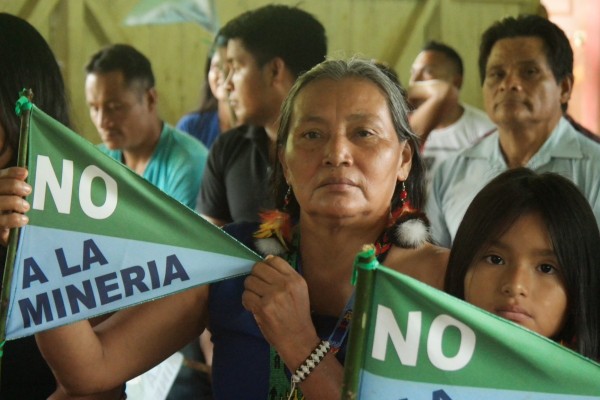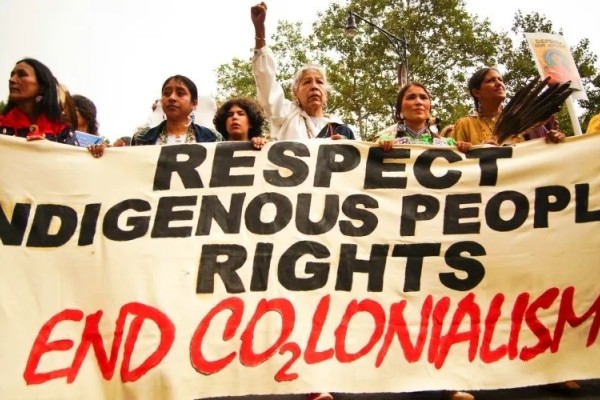Alberta’s Bill 1 and the ongoing suppression of Indigenous movements
Classifying private property as ‘critical infrastructure’ is an ideological articulation frequently used to criminalize activism

Premier Jason Kenney and Cabinet are sworn in at Government House, in Edmonton, April 30, 2019. Photo by Chris Schwartz/Government of Alberta/Flickr.
The Alberta government’s Bill 1—the Critical Infrastructure Defense Act—will likely soon be law, implementing new restrictions on what is considered legal protest, along with severe fines and sentences for anyone charged under the act.
The introduction of the bill has not been without criticism, with legal experts, members of Alberta’s official opposition, and organized labour all voicing concerns that the far-reaching legislation will impinge on charter rights to peaceful assembly and protest. Many in the Indigenous and environmental justice communities who will most likely be targeted under this legislation, however, were unsurprised by its authoritarian implications.
“We know we’re not meant to win in the courts, and that’s how it has always been,” said Veronica Fuentes, an organizer with Beaver Hills Warriors in Amiskwaciwâskahikan (Edmonton). “It affirmed a lot of assumptions on how the provincial government understood our work. This was a direct response to what we had done.”
The occupation of an Edmonton BMO branch and the blockade of a CN rail line west of the city that sparked the rapid drafting of Bill 1 were part of the nationwide campaign of solidarity actions in support of the Wet’suwet’en people earlier this year. At the heart of the conflict between the Wet’suwet’en hereditary chiefs and Coastal GasLink is the question of Indigenous sovereignty and right to control over their territories, an issue that is ever-present in the relationship between First Nations and the Canadian state.
“Even Parks Canada, the way that it exerts understanding of territory undermines the knowledge systems that have existed since time immemorial,” Fuentes told Canadian Dimension. “That is white supremacy to assume that Indigenous people don’t have the capacity, are not fit in the modern world to take care of territory and to determine the future of territory. And I think Bill 1 is just a regurgitated articulation of that.”
The classification of private property as “critical infrastructure”—and the accompanied collusion between corporate actors and Canadian police, intelligence, and security agencies—is another such ideological articulation, one that frequently criminalizes activists challenging government claims on traditional territories or asserting their right to self-determination.
Since the mid-2000s, the critical infrastructure designation has expanded to include pipelines, railways, and—in the United Conservative Party’s exhaustive list—sidewalks or vaguely defined “processes.” The development of this legal category has coincided with an increase in collaboration between Canadian security agencies and private corporate interests. In a 2007 briefing forum between CSIS and the Canadian Association of Petroleum Producers (CAPP), the security agency outlined their shift in focus away from foreign national security threats to domestic “critical infrastructure protection,” welcoming a new era of “partnerships” and “enhanced intelligence and information sharing” with corporations.
One outgrowth of this corporate-police symbiosis was Project SITKA, wherein the RCMP’s National Intelligence Coordination Centre (NICC) gathered intelligence on 313 Indigenous rights activists. Of these, 89 were deemed threats that “meet the criteria of criminality associated to public order events” whose “primary common interest was natural resource development….” Over half were involved in the Mi’kmaw struggle against fracking in Elsipogtog. Profiles were created for these 89 “core subjects” including photos and private information, which were then shared not only with various law enforcement agencies, but with private industry partners.
Surveillance of opponents to the Northern Gateway Pipeline was similarly organized under the guise of critical infrastructure protection, framing Unistot’en Clan members and other Indigenous communities opposed to the project as “environmental criminal extremists.” From the earliest intelligence meetings surrounding the pipeline, Enbridge was included alongside local, provincial, and federal policing agencies, and continues to enjoy a two-way sharing of information gathered through open-source, covert, and undercover methods. British Columbia’s Aboriginal Policing Services and the RCMP’s Critical Infrastructure Intelligence Team (CIIT) and Aboriginal Intelligence Group (AIG) all devoted considerable resources to the tracking of individuals deemed a threat to the pipeline, despite it being only in the proposal phase and not constituting actual infrastructure.
Much of the rhetoric that politicians invoked to delegitimize the widespread opposition to the Northern Gateway pipeline has been reiterated by Kenney and other UCP members—calling them “extremists” or “radicals” and asserting that there is some organized conspiracy involving foreign-funded environmentalists set on disrupting Canada’s energy industry.
One novel turn in Alberta’s ongoing dispute over pipelines, blockades, and Aboriginal title, is Premier Jason Kenney and the UCP’s concerted effort to deny that the movement is Indigenous-led. Instead, the source of opposition to oil and gas projects in the province has been attributed to “urban-green-left-zealots” and “spoiled kids” concerned with social media clout.
For Fuentes, the government’s discursive strategy is another facet of the ongoing settler colonial project.
“When we say Indigenous erasure, we don’t just mean us as individuals, we’re talking about our whole governing systems, and agreements made with the crown, agreements made with Canada. So, this whole narrative that [the blockade] wasn’t Indigenous-led, often I found that narrative came from a place of delegitimizing Indigenous communities, people, groups that were asserting their inherent right to self-governance.”
While critics have rightfully identified flaws in Bill 1 that could infringe on all Albertans’ charter-protected rights, an analysis of the way that the critical infrastructure security framework has historically been used in Canada suggests that Albertans’ experiences with the new law will be far from equal.
Some interest groups may be able to adopt new tactics and avoid the penalties contained in the bill, but in a politico-legal perspective that categorizes the re-emergence of traditional Indigenous models of governance as a threat, there is little option but for these activists to come into confrontation with it.
“We have an accountability to the land that often doesn’t exist in other families or in other people,” said Fuentes, emphasizing the implications this has within the activist community as well.
“I often talk about the way settlers can move around in what is understood as climate justice, they can work for these NGOs—they can volunteer here, volunteer there, I call it a ‘settler privilege of mobility.’ At the end of the day, many people can walk away from it and have no accountability to the territory, to the community, to the food systems, to the knowledge systems, to the water.”
Fuentes’ insight has serious implications for how opposition to the growing police state infrastructure in the province manifests. Legal challenges to Bill 1 pertaining to constitutionality or treaty rights could be tied up in the courts for months or longer, while the number of people facing criminal charges for protecting the land and their community grows.
The province may eventually be forced to repeal Bill 1, but in the meantime, standing in opposition to this draconian legislation must mean standing on the front lines with the communities who will be most detrimentally affected by it.
Brett McKay is a writer and journalist based in Edmonton, AB. Follow him on Twitter @brettemckay.










